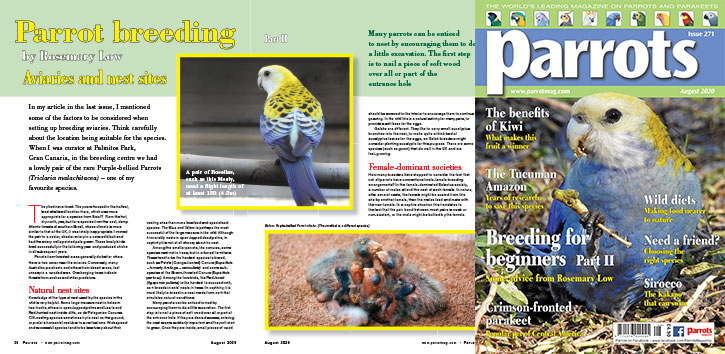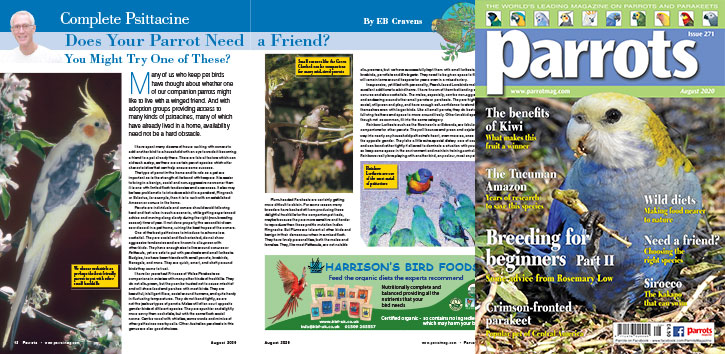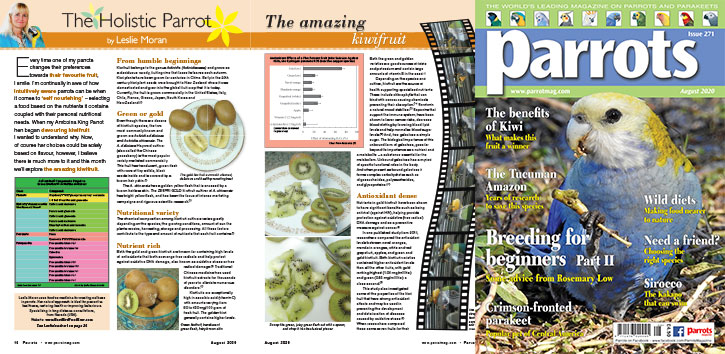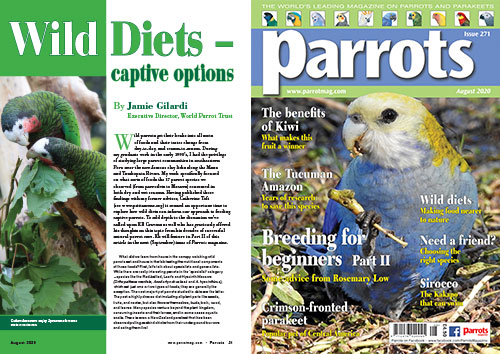
Part II – Aviaries and nest sites
In my article in the last issue, I mentioned some of the factors to be considered when setting up breeding aviaries. Think carefully about the location being suitable for the species. When I was curator at Palmitos Park, Gran Canaria, in the breeding centre we had a lovely pair of the rare Purple-bellied Parrots (Triclaria malachitacea) – one of my favourite species.
They had never bred. They were housed in the hottest, least sheltered location there, which was more appropriate for a species from Brazil? From the hot, dry north, yes, but for a species from the cool, damp Atlantic forests of southern Brazil, whose climate is more similar to that of the UK, it was totally inappropriate. I moved the pair to a cooler, shadier aviary in a covered block and had the aviary walls painted pale green. These lovely birds bred successfully in the following year and produced chicks in all subsequent years.
Parrots from forested areas generally do better where there is tree cover near the aviaries. Conversely, many Australian parakeets and others from desert areas, feel uneasy in a wooded area. Overhanging trees indicate threats from snakes and other predators.
Buy Now!

Does Your Parrot Need a Friend? You Might Try One of These?
Many of us who keep pet birds have thought about whether one of our companion parrots might like to live with a winged friend. And with adoption groups providing access to many kinds of psittacines, many of which have already lived in a home, availability need not be a hard obstacle.
I have spent many dozens of hours working with owners to add another bird to a household with an eye towards it becoming a friend to a pet already there. There are lots of factors which can aid such a step, as there are certain parrot species which offer characteristics that can help ensure some success.
The type of parrot in the home and its role as a pet are important as is the strength of its bond with keepers. It is easier to bring in a benign, social and non-aggressive newcomer than it is one with limited flock tendencies and awareness. It also may be less problematic to introduce a bird to a parakeet, Ringneck or Eclectus, for example, than it is to work with an established Amazon or conure in the home.
Buy Now!

The amazing kiwifruit
Every time one of my parrots changes their preferences towards their favourite fruit, I smile. I’m continually in awe of how intuitively aware parrots can be when it comes to ‘self nourishing’ – selecting a food based on the nutrients it contains coupled with their personal nutritional needs. When my Amboina King Parrot hen began devouring kiwifruit I wanted to understand why. Now, of course her choices could be solely based on flavour, however, I believe there is much more to it and this month we’ll explore the amazing kiwifruit.
Kiwifruit belongs to the genus Actinidia (Actinidiaceae) and grows as a deciduous woody, fruiting vine that loses its leaves each autumn. Kiwi plants have been grown for centuries in China. Early in the 20th century kiwi plant seeds were brought to New Zealand where it was domesticated and grew into the global fruit crop that it is today. Currently, the fruit is grown commercially in the United States, Italy, Chile, France, Greece, Japan, South Korea and New Zealand.
Even though there are dozens of kiwifruit species, the two most commonly known and grown are Actinidia deliciosa and Actinidia chinensis. The A. deliciosa Hayward cultivar (also called the Chinese gooseberry) is the most popular variety marketed commercially. This fruit has translucent, green flesh with rows of tiny edible, black seeds inside and is covered by a brown hairy skin.
Buy Now!

By Jamie Gilardi, Executive Director, World Parrot Trust
Wild parrots get their beaks into all sorts of foods and their tastes change from day-to-day, and season-to-season. During my graduate work in the early 1990’s, I had the privilege of studying large parrot communities in southeastern Peru near the now-famous clay licks along the Manu and Tambopata Rivers. My work specifically focused on what sorts of foods the 17 parrot species we observed (from parrotlets to Macaws) consumed in both dry and wet seasons. Having published those findings with my former advisor, Catherine Toft (see www.psittascene.org) it seemed an opportune time to explore how wild diets can inform our approach to feeding captive parrots. To add depth to the discussion we’ve called upon EB Cravens as well who has graciously offered his thoughts on this topic from his decades of successful natural parrot care. Eb will feature in Part II of this article in the next (September) issue of Parrots magazine.
What did we learn from hours in the canopy watching wild parrots eat and hours in the lab testing the nutritional components of those foods? First, let’s talk about specialists and genera lists. While there are really interesting parrots in the ‘specialist’ category – species like the Red-bellied, Lear’s and Hyacinth Macaws (Orthopsittaca manilata, Anodorhynchus leari and A. hyacinthinus), which eat just one or two types of foods, they are generally the exception. The vast majority of parrots studied to date are the latter. They eat a highly diverse diet including all plant parts like seeds, fruits, and nectar, but also flowers themselves, buds, bark, wood, and leaves. Many species venture beyond the plant kingdom, consuming insects and their larvae, and in some cases aquatic snails. There is even a New Zealand parakeet that has been observed pulling seabird chicks from their underground burrows and eating them live!
Buy Now!




